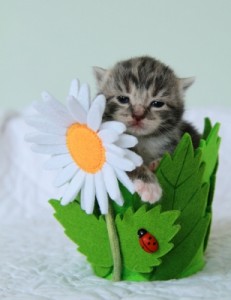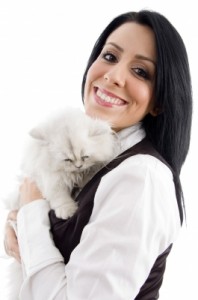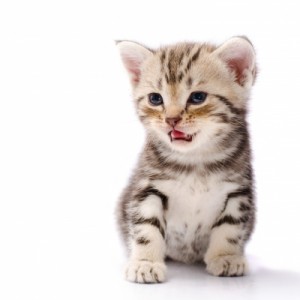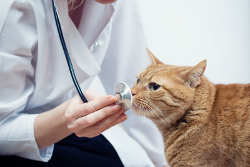SO WHAT IS CAT DANDRUFF?
As their skin rejuvenates, the top layer of our feline friends skin naturally shed dead skin cells, this is called dander. As a pet lover you must not confuse this natural process with a more serious condition called seborrheic dermatitis, or dandruff.
Your cat can have a skin disorder where the sebaceous glands produce too much sebum. This is highly noticeable on the face, flanks and back of a cat with a dark coat. The skin beneath the coat will become flaky, itchy, scaly and red.
Two different forms of seborrhea exist: seborrhea sicca, which is dry seborrhea, and seborrhea oleosa, or oily seborrhea. A combination of both types appears on cats with dandruff.
CAT DANDRUFF CAUSES
Cats with idiopathic seborrhea will have dandruff that does not have an actual cause. This is because idiopathic seborrhea is an inherited disorder which causes excessive sebum production. There is no cure for this condition, however it can be treated and managed. Careful observation is important prior to visiting the veterinarian.
We suggest writing notes on the behaviors, including eating and sleeping habit changes, that indicate health problems. The veterinarian will ask specific questions that provide insight for the diagnosis, so the more information you have the better.
An experienced pet owner should observe their cat for a few days prior to the vet appointment. The most common causes of dandruff are:
- Environmental factors – Temperature and humidity changes cause the skin to dry when the seasons change.
- Hormonal imbalance – The thyroid gland regulates the animal’s metabolic rate, which affects the body temperature. Imbalance can cause dandruff
- Allergies – Skin irritation can come from household cleaners and laundry detergent.
- Fungal infections – Ringworm is a common cause of dandruff in cats.
- Obesity – Heavy cats are unable to maneuver to clean the fur in certain areas, especially the back.
- Parasites – Fleas and ticks cause skin irritation that will lead to dandruff if left untreated.
- Musculoskeletal disease – Pain similar to arthritis will prevent the cat from reaching the fur along the back and tail.
DANDRUFF SYMPTOMS
 Areas of the cat’s coat where there are high concentrations of sebaceous glands will show early signs of dandruff. The back has the highest concentrations and is most visible to you has an owner. Cats may also leave a circle of dandruff flakes in their sleeping area. So that is also a good indication of dandruff.
Areas of the cat’s coat where there are high concentrations of sebaceous glands will show early signs of dandruff. The back has the highest concentrations and is most visible to you has an owner. Cats may also leave a circle of dandruff flakes in their sleeping area. So that is also a good indication of dandruff.
Another critical sign to take note of is the smell of your pet. There is a noticeable odor that accompanies a cat with dandruff. As an owner you are the most familiar with your pets odor look out for new or changes in your cats smell. A yeast skin infection or secondary bacterial infection can cause this odor to be worse.
A cat that swats the owner’s hand when touching certain areas is telling the owner something is wrong. Careful investigation will reveal red, or inflamed, skin with lesions that are dry or oily to the feel. Also the folds of skin on the feet, armpits, thighs and belly will show worse signs of the dermatitis.
DANDRUFF DIAGNOSIS
An experienced vet will conduct various tests to determine the type and cause of the dandruff. The purpose of most tests is to determine the root cause of the condition.
- Blood tests – A complete blood cell count, or CBC, electrolytes and serum chemistries will reveal underlying medical conditions and imbalances in hormone and enzyme levels.
- Skin scrapings and skin cytology
- Skin culture – This test will allow the vet to identify bacterial and fungal infections, such as ringworm
- Skin biopsy
- Hormone tests
CAT DANDRUFF TREATMENTS
Here are some of the most common treatment method and our recommendations:
Other Dandruff Treatment Options to consider:
Remember these critical factors can play a big role in treating your cat:
- Omega-3 fatty acid food supplements
- Retinoids
- Moisturizers
- Antibiotics – for secondary bacterial infections
DANDRUFF PREVENTION
 A cat’s skin will respond to higher humidity levels, fatty acid supplements and sufficient clean water in much the same way that a human’s skin will. Here are some important considerations for the cat’s daily routine. Each one must be included at the right intervals to prevent dandruff.
A cat’s skin will respond to higher humidity levels, fatty acid supplements and sufficient clean water in much the same way that a human’s skin will. Here are some important considerations for the cat’s daily routine. Each one must be included at the right intervals to prevent dandruff.
Some cats need help with keeping the entire coat clean and in good condition. A bath every couple of months can provide the right combination of moisturizer and anti-dandruff shampoo. A gentle brush is a helpful tool to reach through the hair and massage the skin. The bath will also loosen the flakes on the skin. An a thorough rinsing will release the flakes from the hair.
Some cat lovers choose to send the cat to a reliable groomer every 60 days to get the best bath and skin treatment available.
Cats must be flexible and of the optimal weight to be able to groom every part of the coat. Cat dandruff can develop on the back just above the tail. It is also important to note that an obese cat is the perfect candidate for serious health conditions later in life, including diabetes and arthritis.
Monitor the environment
Too much direct sun on the ears, nose and top of the cat’s head can lead to sunburn. A cat’s skin is susceptible to sun damage because there is no natural sun protection in the skin.
Dry air in the winter months can cause skin irritation for the cat. Static in the fur makes petting uncomfortable. A humidifier is the perfect solution. As a side benefit humans experience fewer winter colds in higher humidity.
Do not allow the cat to sleep in front of the fireplace when the logs are crackling. The heat dries out the cat’s skin quickly.
Appropriate diet
Fatty acids and sufficient clean water will work together to maintain the proper moisture content in the cat’s coat and skin. A cat that does not like to drink water will have kidney problems later in life. Sufficient water content in the food is necessary. High-quality canned and dry foods maintain good health and quality of life for many years.
Omega-3 fatty acids are important for the cat’s skin. Supplements are a better source of Omega-3 fatty acids than canned tuna. Cats have a tendency to favor treats over the regular food, which can lead to malnutrition.
Consult the vet
All pet owners learn to identify health situations that require professional medical attention. Delays are not wise when the cat is exhibiting changes in behavior or skin irritation.
TIPS FOR A CAT DANDRUFF-FREE CAT
 A daily routine that supports and promotes a healthy skin and coat is important in the quest to prevent dandruff. Some minor changes to your current routine will improve the chances of controlling or curing the cat’s skin problems. Some of these include:
A daily routine that supports and promotes a healthy skin and coat is important in the quest to prevent dandruff. Some minor changes to your current routine will improve the chances of controlling or curing the cat’s skin problems. Some of these include:
- Brushing the coat – Daily brushing sessions are enjoyable for cats when the right brush is used. Long strokes along the coat will remove loose hair and stimulate the hair follicles. Healthy hair growth ensures that the oils are evenly distributed.
- Proper diet – Good food is important for a healthy cat. Look for specialty foods that have been developed to support the cat’s coat.
- Avoid heat – Cat’s favorite heat sources during the cold months. As I mentioned before, dry skin can become irritated if too much heat is present for long periods.
- Colloidal oatmeal – Moisturizers with colloidal oatmeal add a gentle emollient to the skin.
FINAL WORDS ON CAT DANDRUFF
As a cat lovers, you are the best person to observe the skin health in the family pet. Normal dander is not cause for concern. However, dandruff can be a symptom of severe medical conditions that should be a cause for a veterinarian visit. The wise pet owner will spend sufficient time with the animal to determine if its daily habits and behaviors are changing. Treatment is possible, but prevention is a better choice.
Finally, If you don’t have a feline companion yet, consider visiting your local animal shelter or visit the ASPCA website for more information on your options. Also review our top 5 ways you can help save a pet.
Thanks for visiting the Cat dandruff Clinic, if you liked this article please use our social buttons to vote below.

